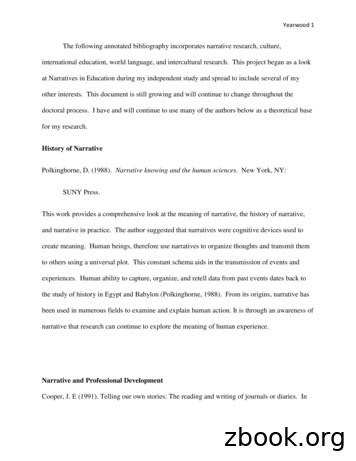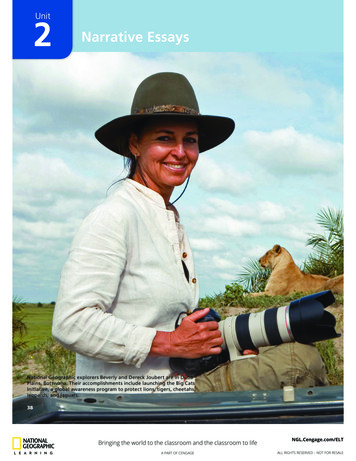Personal Narrative
PersonalNarrativeCommon CoreAlignedUnitGrades 3-5
Table of ContentsNote to the Teacher.page 3Common Core Standards.pages 4-5Teacher Overview (lessons).pages 6-7Personal Narrative Anchor Chart.page 8Ideas Worksheet . page 9Finding a Small Moment Anchor Chart.page 10Small Moment Graphic Organizer.page 11Strong Lead Anchor Chart. page 12Strong Lead Worksheet . page 13Sequence Anchor Charts.pages 14-15Transition Words Anchor Chart. page 16Sequencing Graphic Organizer.page 17Show Not Tell Anchor Chart. page 18Show Not Tell Worksheet . page 19Sensory Details Anchor Chart .page 20Sensory Details Worksheet .page 21Using Dialogue Anchor Chart . page 22Dialogue Worksheet . page 23Powerful Endings Anchor Chart.page 24Self & Peer Editing Checklists.page 25Writing Paper for Final Copy .pages 26-27Publisher’s Party Sign.page 28Publisher’s Chair Sign .page 29Personal Narrative Rubric.page 30
Note to theTeacher.The teacher overviewis an overview of my lesson plans. Iuse the anchor charts to begin mymini lesson, then use the worksheetsto review the concept being taughtthat day. The students are workingon their personal narrativesthroughout the entire unit! I havemy students keep their writing in a“drafting” folder until they arereadyto publish.I actually printed the anchor chartsand hung them in my classroom asI was teaching this unit. If you preferlarger anchor charts on chart paper,you could use these for ideas and make your own.
Personal NarrativeCCSS3rd Grade CCSS.ELA-Literacy.W.3.3 Write narratives to develop real or imagined experiences or eventsusing effective technique, descriptive details, and clear event sequences. CCSS.ELA-Literacy.W.3.3a Establish a situation and introduce a narrator and/orcharacters; organize an event sequence that unfolds naturally. (Day 2- “Small Moment”,Day 3- “Strong Lead”, and Day 4 - “Sequence”) CCSS.ELA-Literacy.W.3.3b Use dialogue and descriptions of actions, thoughts, andfeelings to develop experiences and events or show the response of characters tosituations. (Day 5 - “Adding Dialogue” & Day 6- “Show Don’t Tell & Sensory Details) CCSS.ELA-Literacy.W.3.3c Use temporal words and phrases to signal event order. (Day 4- “Sequence”) CCSS.ELA-Literacy.W.3.3d Provide a sense of closure. (Day 7 - “Strong Ending”)4th GradeCCSS.ELA-Literacy.W.4.3 Write narratives to develop real or imagined experiences or eventsusing effective technique, descriptive details, and clear event sequences. CCSS.ELA-Literacy.W.4.3a Orient the reader by establishing a situation and introducing anarrator and/or characters; organize an event sequence that unfolds naturally. (Day 2“Small Moment”, Day 3- “Strong Lead”, and Day 4 - “Sequence”) CCSS.ELA-Literacy.W.4.3b Use dialogue and description to develop experiences andevents or show the responses of characters to situations. (Day 5 - “Adding Dialogue” &Day 6 - “Show Don’t Tell & Sensory Details) CCSS.ELA-Literacy.W.4.3c Use a variety of transitional words and phrases to manage thesequence of events. (Day 4 - “Sequence”) CCSS.ELA-Literacy.W.4.3d Use concrete words and phrases and sensory details toconvey experiences and events precisely. (Day 6- “Show Don’t Tell & Sensory Details)CCSS.ELA-Literacy.W.4.3e Provide a conclusion that follows from the narratedexperiences or events. (Day 7 - “Strong Ending”)
Personal NarrativeCCSS5th Grade CCSS.ELA-Literacy.W.5.3 Write narratives to develop real or imagined experiences or eventsusing effective technique, descriptive details, and clear event sequences. CCSS.ELA-Literacy.W.5.3a Orient the reader by establishing a situation and introducing anarrator and/or characters; organize an event sequence that unfolds naturally. (Day 2“Small Moment”, Day 3- “Strong Lead”, and Day 4 - “Sequence”) CCSS.ELA-Literacy.W.5.3b Use narrative techniques, such as dialogue, description, andpacing, to develop experiences and events or show the responses of characters tosituations. (Day 5 - “Adding Dialogue” & Day 6- “Show Don’t Tell & Sensory Details”) CCSS.ELA-Literacy.W.5.3c Use a variety of transitional words, phrases, and clauses tomanage the sequence of events. (Day 4 - “Sequence”) CCSS.ELA-Literacy.W.5.3d Use concrete words and phrases and sensory details toconvey experiences and events precisely. (Day 6- “Show Don’t Tell & Sensory Details) CCSS.ELA-Literacy.W.5.3e Provide a conclusion that follows from the narratedexperiences or events. (Day 7 - “Strong Ending”)
Teacher OverviewDayDay OneIdeasDay TwoSmall MomentDay ThreeStrong LeadDay FourSequenceDay FiveAddingDialoguelessonmaterialsDiscuss: What is apersonal narrative? Materials:Share Anchor Chart Personal NarrativeStudents completethe Narrative Ideassheet.Discuss: SmallMomentsStudents completethe small momentcircle map.Discuss:Strong LeadsComplete the strong leadsworksheet together.Choose a strong lead &write a beginningparagraph for personalnarrative.Discuss: Sequence &Transition wordsWrite the middle of theirpersonal narrative insequential order usingtransition words.Discuss: How dialogueadds detail and how toappropriately writedialogue. Completedialogue worksheet.Students should add atleast two dialoguesentences to personalnarrative.Anchor ChartPersonal Narrative IdeassheetMaterials:Small Moment AnchorChartSmall Moments Circle MapMaterials:Strong Leads AnchorChartStrong Lead WorksheetMaterials:Sequence Anchor ChartTransitions Anchor ChartMaterials:Dialogue Anchor ChartDialogue Worksheet
Teacher OverviewDayDay SixShow Don’t Tell&Sensory Details(You may choose to splitthis up into two days)Day SevenStrong EndingDay EightEditingDay NinePublishlessonDiscuss: Showingyour feelings ratherthan telling them &Sensory DetailsmaterialsMaterials:Complete the show Show Not Tellnot tell sensoryAnchor Chartdetails worksheetShow Not TellworksheetAdd showingsentences & sensorydetails to personalnarratives.Discuss: StrongEndingStudents write anending to theirpersonal narrativeMaterials:Strong Ending AnchorChartStudents will use the selfedit checklist and the peer Materials:edit checklist to edit their Peer Edit ChecklistSelf Edit Checklistpersonal narrative.Students will write thefinal copy of their personal Materials:Paper for final copy.narrative.Teacher uses rubric to grade personal narratives.Day TenPublisher’sPartyMaterials:Students will share theirpersonal narratives withtheir classmates!Whatever makes yourstudents feel special &proud of their writing! (forexample.a publisher’schair!)
personalNarrativeTells about an event thathappened to you.
Personal NarrativeA New PetIdeasBest Dayor Worst DayA Birthday PartyFirst Dayof SchoolA Vacation/ PlaceYou VisitedA Scary MomentFamilyMemoryMost EmbarrassingMomentA Time YouLearnedSomething New
oryStedSedemoZo!niVery specific!Not toomanydetails!The mostimportant part of abig story!Personal NarrativeFinding a Small MomentNot focused!ynamoTo ails!detNot zoomedin enough!Too broad!nolemretcaiw top
Personal Narrative“Small Moment”Small MomentDetails
Create aStrong Lead with.an action.a snapshot.a flashback.a question.onomatopoeia.dialogue.evitarraNlanosrpe
Writing a Strong LeadHere are some examples of ways you can start a personal narrative witha strong lead. Read the example and then write your own for your smallmoment.My Small Moment:Dialogue (talking): “Look out!” shouted my best friend.Onomatopoeia (sound effect): “Whizzzz,” sounded the ball as itflew by my head.Action Lead: I leapt out of the way like I was on fire as the ballflew right by head.Snapshot: The ball quickly flew by my head and I wondered whyit even came in my direction.Question: Have you ever been in a situation where you werescared for your life?Flashback: It was a typical day at recess, until I saw my life flashbefore my eyes.
SequenceBeginning - The beginningcatches the reader’s attention.Middle - The middle gives detailsand examples of what happenedduring the small moment.Ending - The ending tellshow you feel now, what youlearned, or how you were changed.
SequenceGood writerswrite their storyin order of howit happened.FirstThenNextFinally
allynextmeanwhilesecond
Writing in sequenceNextFirstThenFinallyAfter That
Shownot tellWeour feelings.Telling: I was angry.Showing: I kicked the dooras I walked out ofthe room.
Show not tellChange these “telling” sentences into “showing” sentences.I was happy.We lost. I was sad.My room was very messy.I was sad.I was really scared.I was angry.
SensoryDetailssmelltastetouchhearsee
SmellHearTasteTouchClose your eyes and think about your experience. What did you see, smell, hear,taste, and touch? Open your eyes and write what you thought about in each box.SeeUse Sensory Details to “Show”
UseDialogueto add detail.taemittdiaaesrIg”a,pdam“I h mer ca om.mmysu to m
Adding dialogueFix these sentences so the dialogue is correct.My dog ran away said my best friend.have you ever scored a touchdown asked the coach.my teammate shouted watch out for the ball.Write a dialogue sentence that would be saidin each situation.at a football gameat the grocery storeduring recess
PowerfulendingsWrite an ending that.tells how you feel now,what you learned,R how you changed.O
Self edit checklistRead your personal narrative and complete the check list.yes/noMy main idea is a small moment, not a big watermelon idea.I have a good title that relates to my main idea.My main idea is evident in the first paragraph.My conclusion reinforces my main idea. My story has a good ending.My story is well organized in the order of what actually happened.I checked the spelling and capitalization of all words.I used descriptive words to make it easy for the reader to visualize what is happening.peer edit checklistHave a friend read your personal narrative and complete the check list.NeedsworkgoodOutstandingThe story holds the reader’s interest.Story is well organized and easy to read.All words are properly spelled & capitalized.The main idea is evident in the first paragraph.Story has a clear beginning, middle, and ending.Author included descriptive words to make it easy forthe reader to visualize what is happening.
Personal Narrativeby
OutstandingName:Personal Narrative RubricPtocelebrate our.sevitarraNlanoserMost events are clearlyin chronological order.There is a beginning,middle, and endingGood use of detailmaking parts of thestory easy to visualize.All events are clearly inchronological order.There is a clearbeginning, middle, andending.Excellent use of detailmaking it easy for thereader to visualize yourstory.MechanicsOrganizationDetail/ ElaborationNot much detail makingit difficult for the readerto visualize.Events are in a randomorder. There is not aclear beginning, middle,or ending.There are severalspelling, punctuation, orcapitalization errors.3/ 15 pointsThere are very fewspelling, punctuation, orcapitalization errors.4SatisfactorySpelling, Punctuation, andCapitalization are usedappropriately. Nomistakes are made.5NeedsImprovementWe arehavinga publisher’sparty
Author’sChairPetarraNlanosr!seiv
Most events are clearlyin chronological order.There is a beginning,middle, and endingGood use of detailmaking parts of thestory easy to visualize.All events are clearly inchronological order.There is a clearbeginning, middle, andending.Excellent use of detailmaking it easy for thereader to visualize yourstory.MechanicsOrganizationDetail/ ElaborationNot much detail makingit difficult for the readerto visualize.Events are in a randomorder. There is not aclear beginning, middle,or ending.There are severalspelling, punctuation, orcapitalization errors.3NeedsImprovement/ 15 pointsThere are very fewspelling, punctuation, orcapitalization errors.45Spelling, Punctuation,and Capitalization areused appropriately. Nomistakes are made.SatisfactoryOutstandingName:Personal Narrative Rubric
Thank you for purchasingmy product!Terms of Use:Each page of this document iscopyrighted. You may notclaim any part of thisdocument as your own.This document is designed forpersonal use. in one classroomonly. Please purchaseadditional licenses for use inmultiple classrooms. :Credits:www.kevinandamanda.com
My main idea is a small moment, not a big watermelon idea. _ I have a good title that relates to my main idea. _ My main idea is evident in the first paragraph. _ My story is well organized in the order of what actually happened. _ My conclusion reinforces my main idea. My
development. The narratives discussed in this article included (1) narrative of social criticism, (2) narrative of apprenticeship, (3) narrative of reflective practice, (4) narrative of journey, and (5) narrative of hope. Each of these forms provides an avenue for further discovery, development, and growth that not only can help create a second self for teachers, but also build more meaningful .
types of Narrative Writing: 1. Personal Narrative: When a person writes about himself or about his experiences. In this style of narrative writing, the writer already has a plot. Name one example of a personal narrative we have read this year. Grandpa She doesn't get eaten by the eels at this time The Grandson What? Grandpa The eel doesn't get her.
A narrative essay tells a story. In fact, narrative is another word for story. In this unit, you will learn how to organize and write a narrative essay. Even though the narrative essay has the same basic form as most other academic essays, it allows the writer to be a little more creative than academic essays usually do.
difference between a compiled genealogy, a narrative genealogy, a narrative lineage, and a narrative pedigree?”, Certification: Frequently Asked Questions (FAQ).] The operative word in the BCG Application Guide is narrative. Charts, family group sheets, non-narrative pedigrees and the like will not satisfy the requirement.
The Interesting Narrative of the Life of Olaudah Equiano . UNDERSTANDING Gustavus Vassa, or Olaudah Equiano, was the first successful professional author of African descent in the English-speaking world. His Interesting Narrative is a spiritual autobiography, captivity narrative, travel book, ad
narrative theory’s focus over the past forty years—from literary narrative to narrative . and postmodern guises, and in their oral, print, visual (film, sculpture, painting, performance), digital and multi-media formats. In this way, narrative theory has gone much further down the road that Scholes and Kellogg travelled in 1966. While .
acknowledge the narrative statement in MyPerformance or on the DD Form 2906. Creating a Narrative Statement Steps to Create a Narrative Statement 1. On the MyPerformance Main Page, select the performance plan you want to create a narrative statement for, make sure Action column reflects Update and select Go button. You
The concepts of narrative and life story have become a significant part of the repertoire of the social sciences since the mid-1950s. There have been several proponents [1-10] of the importance of narratives in qualitative research. A narrative is a story that conta























